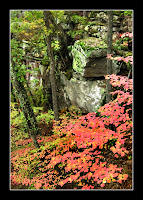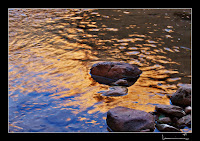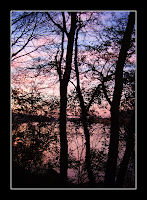 Like so many other film_to_digital photographers the first digital tools I experimented with were saturation and sharpness. With a few simple mouse clicks my previously dull and otherwise not so interesting image could be brought up to a new level. One that I imagined more closely matched my perceptions of the scene when the shutter was tripped.
Like so many other film_to_digital photographers the first digital tools I experimented with were saturation and sharpness. With a few simple mouse clicks my previously dull and otherwise not so interesting image could be brought up to a new level. One that I imagined more closely matched my perceptions of the scene when the shutter was tripped.After all, I was there, I ought to know. So was the sunset not truly as crisp and colorful as my newly saturated and sharpened image suggested? Did I go too far and step over some invisible line that took my work from photograph to digital art? To be honest, I worried about such things.
These days I don't worry about it so much, though I try to remain thoughtful whenever using these tools. They are easy to overdo, and I have certainly done it.
I should also mention that, early on with digital, I had a definite fascination with purposely going too far. Sometimes in the name of enhancement, and sometimes to salvage images that otherwise failed to meet my expectations. Ultimately, though, I decided it was not something that I wanted to do on a regular basis. My photoshop skills were sub par. I did good, in my opinion, to not
 oversaturate, to not over sharpen, and my early digital art creations were often disappointing given the mind-numbing amount of work required to create them. I still consider myself a photoshop novice, and the thought of layers makes me ill. I can use a few simple ones, but I have never really tried to master them. Kudos to those that feel at ease with these tools.
oversaturate, to not over sharpen, and my early digital art creations were often disappointing given the mind-numbing amount of work required to create them. I still consider myself a photoshop novice, and the thought of layers makes me ill. I can use a few simple ones, but I have never really tried to master them. Kudos to those that feel at ease with these tools.Part of my reluctance towards layers was in their seeming complexity. They may not be that hard, but they required more effort than I initially cared to invest. Besides, I usually work in RAW and developed a certain fondness for reworking the image several times. Once perhaps for web viewing, later as a print, then again as different crop or to try some other technique. The first few runs would be like practice, and once I started sharing the image it was like performing the same song to a different audience each time.

Another thing I began to work with after going digital was the ability to crop. I wasn't used to having so much freedom when it came to choosing the final composition. With film I felt bad if I shaved a little here or there, but with digital you could crop heavily with 3 megapixels and still manage a great web image and usually a decent 8x10. And now, with 6 or more megapixels being the norm, you can carve an image up like a butcher if you want.
Times have certainly changed.
Oh yes. Three images today. A old digital art piece (dogwood in fall colors on Petit Jean mountian), a sunrise image of rocks in Negro Bill creek, Utah, and sunset shot of the Arkansas river.

3 comments:
MM dogwood in the fall what can top that!! I wish to try to grow some here but we do not have enough shade to do so - I enjoyed reading your thoughts on post work and how you go about it. I am slowly finding my way with some of it too and agree I seldom know when to stop at the right point LOL... Enjoy
Dear Sir,
Your images arrived upon my monitor in a state that was in no way natural. No matter how I adjust the screen they seem to remain beyond my ability to fix them. It has occurred to me that they might have become somehow corrupted in transit, perhaps hit by a beta particle or subject to packet loss?
Regardless, I seem to only be able to make them look the way that I think they should look by rephotographing the screen with my Ansco Tripper, and having the drug store process the AnscoChrome daylight slide film as if it were AnscoChcrome indoor print film - while the technician leapt into the air, twirling as he spat toward the moon.
Unfortunately I lack a scanner, so I cannot show you the final work which makes up for in color cast what it looses in resolution. But I recommend the technique next time you want to overcome the odd color shifts and stuff that happen to your otherwise nifty images.
I am sorry that my monitor resulted in a manipulation of your very excellent photography but I am overwhelmingly pleased with the manipulations my technique has created out of them.
Thank you for sharing...
T.
Now for reality... I liked the images a bunch Michael... but I couldn't resist an Organic Photographer review. They have been pouring into some of the forums upon which I post some of my stuff... and if I have to deal with the strange disconnect between the keepers-of-a-day-gone-bye and the reality of the direction of real photography... well then a serious provocation like these images in this posting should as well.
I mean, haven't you been told by anyone that these creative, eye popping images of yours are JUST NOT PHOTOGRAPHY?
AAARGH!
Um, nice work. Thanks for letting me vent...
Post a Comment